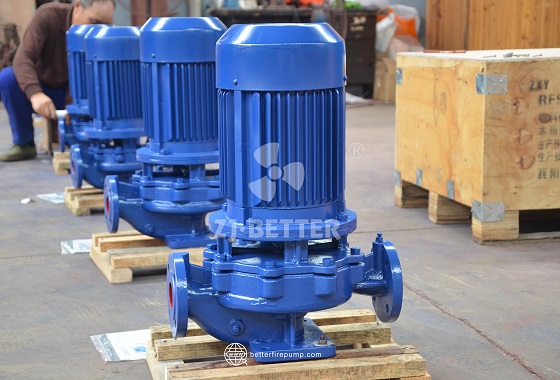In the context of rapid urbanization, increasing building density and dwindling spatial resources have posed unprecedented challenges to the configuration of fire protection systems. Traditional large-scale fire pump systems, due to their bulky size and complex installation requirements, are difficult to deploy in many high-rise buildings, underground spaces, or compact equipment rooms, severely impacting the flexibility and reliability of fire protection systems. To address this practical need, integrated vertical pipeline pumps have emerged as an ideal solution for modern building fire protection water supply systems, offering advantages such as compact structure, vertical layout, easy installation, and stable operation.
1. Compact structural design with minimal space requirements
Integrated vertical pipeline pumps adopt a inline structure, with the motor and pump body coaxially mounted, eliminating the need for the base and coupling connection structure required by traditional horizontal pumps, significantly reducing the overall dimensions. This design allows the entire pump to be directly installed on the pipeline, eliminating the need for dedicated equipment foundations or complex support structures. This not only saves valuable machinery room space but also simplifies system layout. For space-constrained environments such as high-rise buildings, underground shopping malls, and subway tunnels, this compact design is particularly important. Its installation method is flexible and versatile, supporting both horizontal and vertical installation to accommodate different flow direction requirements.
2. Quick and easy installation process
The pump features high structural integration and a simple installation process, eliminating the need for complex on-site assembly or specialized foundation construction. The entire unit is fully tested and commissioned before leaving the factory. Upon receipt, customers only need to connect the piping and power supply to achieve rapid installation and commissioning. This feature significantly reduces construction time and labor costs, making it particularly suitable for fire protection retrofit projects and new construction projects with stringent construction schedules. Compared to traditional pump systems, which often require several days for installation, this pump typically only takes a few hours to install, greatly improving project efficiency.
3. Stable operation with minimal vibration and low noise
The vertical structure offers natural axial alignment advantages, combined with high-precision machining and dynamic balancing, resulting in minimal vibration and low operational noise during pump operation. This significantly enhances the pump's operational stability. This feature not only improves the user experience but also extends the service life of both the pump and motor. For noise-sensitive environments such as hospitals, office buildings, and hotels, the pump's quiet operation is particularly notable, effectively reducing environmental noise within the pump room.
4. Reduced piping layout costs
Since the inlet and outlet are on the same axis, piping connections do not require additional adapters or elbows, greatly simplifying the system's piping layout and reducing the procurement of components and construction workload. Additionally, it minimizes head loss caused by changes in water flow direction, improving the system's hydraulic efficiency. This optimized flow path design not only enhances overall system efficiency but also indirectly reduces energy consumption and operational costs.
5. Easy maintenance, no need to dismantle pipes for repairs
Core components of the vertical pipe pump, such as the impeller, mechanical seal, and motor, can be directly removed and replaced from the top of the pump without moving the connected pipework or dismantling the entire pump body. This significantly improves maintenance efficiency and reduces system downtime. For fire protection systems requiring high reliability, this rapid recovery capability is critical, ensuring the fire protection system remains in efficient operation at all times and is ready to respond to sudden fires.
6. Multiple material options to accommodate diverse media
Depending on the application environment and conveyed medium, this series offers material configurations such as cast iron, stainless steel, and bronze to meet users' personalized requirements for corrosion resistance, high-temperature resistance, and other performance characteristics. Especially in fire protection systems conveying poor-quality water, liquids containing impurities, or in environments with significant temperature fluctuations, selecting the appropriate material can effectively extend equipment lifespan and enhance system stability.
7. Energy-efficient and environmentally friendly, compliant with modern green standards
This pump features high-efficiency motors and an optimized hydraulic design, significantly improving hydraulic efficiency and reducing power consumption. It meets national energy efficiency standards and green building energy-saving requirements. Compared to traditional fire pumps, the integrated vertical inline pump achieves lower energy consumption under the same head and flow conditions, embodying green and environmentally friendly principles. For project owners concerned about long-term operational costs and carbon emissions, this energy-efficient equipment is an ideal choice.
8. Intelligent control system integration convenience
Modern fire protection systems have increasingly stringent requirements for automation and remote monitoring. This pump can be optionally equipped with various intelligent control modules to achieve automatic start-stop functions, real-time monitoring of operational status, fault alarms, and seamless integration with Building Automation Systems (BAS) or fire alarm control panels. Through standard communication interfaces such as RS485 and Modbus, users can easily integrate it into existing monitoring platforms to achieve intelligent maintenance and enhance overall system management efficiency.
9. Wide range of applications to meet various fire protection scenarios
Whether in high-rise residential buildings, commercial complexes, industrial plants, underground garages, airports, or subway stations, this pump can adapt to the fire protection needs of different buildings and operating conditions. Its various models and specifications can meet different flow and head requirements, and flexible networking enables multiple combinations such as main pump, standby pump, and multiple pumps in parallel operation, providing greater flexibility and safety for system configuration.
In the context of fire protection systems increasingly moving toward intelligent, integrated, and efficient development, the integrated vertical pipeline pump offers a series of prominent advantages, including compact size, quick installation, stable operation, easy maintenance, and energy efficiency and environmental protection. It provides an ideal fire protection water supply solution for modern buildings. Not only does it enhance system deployment efficiency and operational reliability, but it also aligns with the trends of green buildings and smart cities, making it a key driver for technological upgrades in the fire protection industry.
